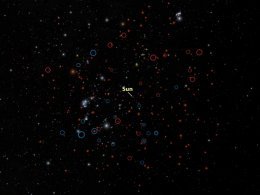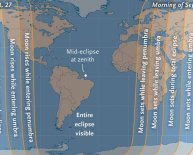
Galaxies from Earth
 NASA has just discovered a group of galaxies far, far away — so far, in fact, that it set a new record for the most distant ever discovered. The cluster of galaxies, named CL J1001+0220 (or CL J1001 for short), resides a whopping 11.1 billion light-years from Earth. Astronomers found the distant cluster of galaxies using a combination of observations from NASA's Chandra X-ray Observatory and several other space telescopes.
NASA has just discovered a group of galaxies far, far away — so far, in fact, that it set a new record for the most distant ever discovered. The cluster of galaxies, named CL J1001+0220 (or CL J1001 for short), resides a whopping 11.1 billion light-years from Earth. Astronomers found the distant cluster of galaxies using a combination of observations from NASA's Chandra X-ray Observatory and several other space telescopes.
Of the 11 galaxies in the cluster, nine appear to be experiencing a firestorm of new star births. "This galaxy cluster isn't just remarkable for its distance, it's also going through an amazing growth spurt unlike any we've ever seen, " Tao Wang of the French Alternative Energies and Atomic Energy Commission (CEA) and lead investigator in the discovery, said in a statement.
CL J1001 appears to be a newborn galaxy cluster in its earliest stage of evolution, something astronomers have not witnessed before, NASA officials said in a statement. Because it takes light 11.1 billion years to reach Earth from this cluster, studying this distant galactic group provides astronomers with a window into the past. The discovery of CL J1001 means that the earliest galaxy clusters formed around 700 million years sooner than previously thought. [The X-Ray Universe as Seen By Chandra Observatory (Gallery)]
The only crowds of galaxies known to exist farther away than CL J1001 are loosely packed protoclusters, or collections of galaxies that aren't close enough to be considered a true cluster. To qualify as a cluster, the galaxies must be bound together by gravity. CL J1001 is now the earliest example of galaxies that have come together to form a gravitationally bound cluster.
Galaxy cluster CL J1001+0220 is the most distant cluster ever discovered. This image is a composite of X-ray, infrared and radio observations from several telescopes.
Credit: X-ray: NASA/CXC/CEA/T. Wang et al; Infrared: ESO/UltraVISTA; Radio: ESO/NAOJ/NRAO/ALMA
"It appears that we have captured this galaxy cluster at a critical stage just as it has shifted from a loose collection of galaxies into a young, but fully formed galaxy cluster, " study co-author David Elbaz said in the statement.
The discovery of this newly formed cluster in the midst of a baby boom of star births suggests that more star formation happens after galaxies join a cluster than when they exist in isolation. Outbursts of new star formation are also more rapid and violent in a cluster, the study suggests.
"We think we're going to learn a lot about the formation of clusters and the galaxies they contain by studying this object, " said co-author Alexis Finoguenov of the University of Helsinki in Finland, "and we’re going to be searching hard for other examples."
Email Hanneke Weitering at hweitering@space.com or follow her @hannekescience. Follow us @Spacedotcom, Facebookand Google+. Original article on Space.com















